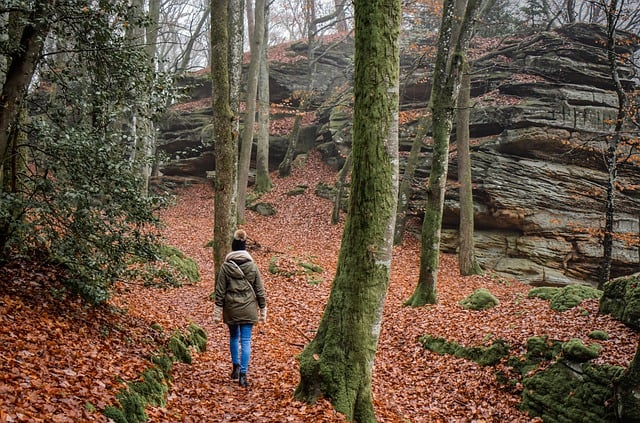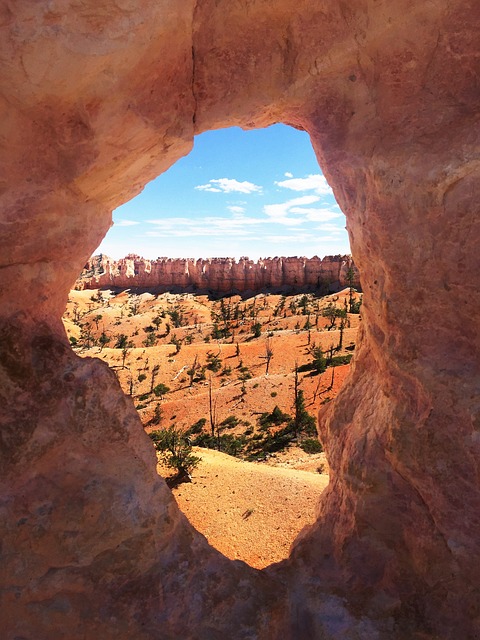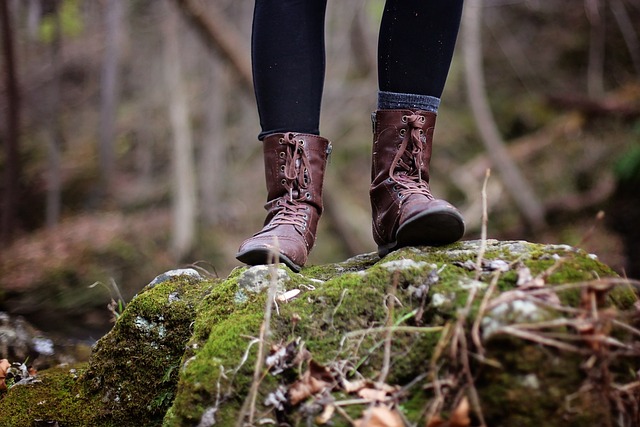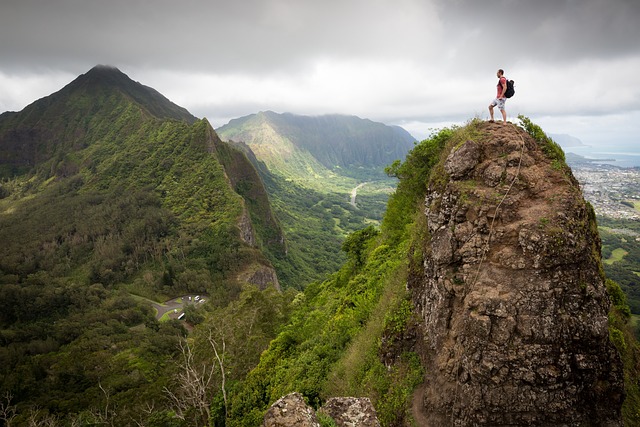
When selecting a flashlight for multi-day hikes on trails, prioritize durability with materials like aircraft-grade aluminum or reinforced polymer composites, and ensure it has an IPX7 or higher waterproof rating to withstand various weather conditions. Choose LED technology for optimal light efficiency and longevity; models like the Fenix HM65R and Streamlight Pro Reach LED are highly recommended for their performance and ergonomic design. Adjustable brightness settings are crucial for conserving battery life, and it's wise to pack spare batteries or a charging solution. Familiarize yourself with all functions, including emergency signaling features. Regular upkeep includes inspecting for wear, cleaning the lens, and checking for corrosion in the battery compartment. Maintain your flashlight by storing it in a cool, dry place, replacing seals as needed, and understanding its user manual to optimize its functions for sustained performance during your hiking adventures. Always keep your flashlight accessible and consider using a lanyard for hands-free operation. By following these tips, your flashlight will be a reliable source of light, enhancing both your safety and the overall experience while navigating hiking trails at night.
When venturing into the wilderness for multi-day hikes, a dependable light source is indispensable. This article illuminates the significance of flashlights for hiking trails, focusing on their key features, from battery efficiency to durability against the elements. We’ll guide you through selecting the optimal power source and design, ensuring your flashlight stands up to rigorous use and harsh conditions. With insights into top-performing models that balance value with longevity, and practical tips for optimal use, your hiking adventures will be well-lit. Additionally, we’ll cover maintenance strategies to maintain your flashlight’s reliability over time. Prepare to navigate the night with confidence as you explore the great outdoors.
- Understanding the Importance of Reliable Light Sources for Multi-Day Hikes
- Key Features to Look for in Flashlights for Hiking Trails
- Battery Life and Efficiency: Choosing the Right Power Source for Your Flashlight
- Durability and Design: How to Select a Flashlight That Can Withstand the Elements
- The Best Flashlights for Hiking Trails: Top Picks Based on Performance and Value
- Practical Tips for Using Flashlights During Multi-Day Hikes
- Maintenance and Care for Your Hiking Trail Flashlight to Ensure Long-Term Reliability
Understanding the Importance of Reliable Light Sources for Multi-Day Hikes

When venturing out on multi-day hikes, the reliability of your light sources becomes a pivotal aspect of your journey. As night falls, flashlights for hiking trails become indispensable tools, ensuring that each step is taken with confidence and clarity. The right lighting can not only illuminate the path ahead but also enhance safety by deterring wildlife encounters and avoiding potential obstacles on the trail. Durability and battery life are key factors when selecting a flashlight for such excursions; a high-quality, long-lasting light source can mean the difference between a successful trek and an unnecessarily challenging one.
The importance of reliable light sources extends beyond mere visibility. On multi-day hikes, where you might find yourself navigating through diverse terrains from dusk till dawn, flashlights for hiking trails become integral to your survival kit. They can be a critical asset in setting up camp, preparing meals, and even signaling for help if necessary. The best flashlights are those that offer multiple modes—high, medium, and low beams—allowing hikers to conserve battery life when full illumination isn’t needed. Investing in a dependable flashlight tailored for the demands of hiking trails is a decision that can significantly enhance the overall experience of your outdoor adventure.
Key Features to Look for in Flashlights for Hiking Trails

When selecting a flashlight for multi-day hikes, durability and reliability are paramount. A high-quality flashlight designed for hiking trails should be constructed with robust materials that can withstand the rigors of outdoor conditions. Look for flashlights made from aluminum alloys or hard-anodized finishes that provide both lightweight and sturdy performance. Additionally, the design should incorporate a secure grip to ensure it doesn’t slip out of your hands when trails are wet or muddy.
Lumens output is another critical feature; a bright beam can illuminate distant paths and signal for help if necessary. A flashlight for hiking trails should offer multiple brightness settings, allowing you to conserve battery life on low settings and have a powerful high beam when needed. Furthermore, consider the type of batteries the flashlight uses—rechargeable lithium-ion or alkaline are preferred due to their longevity and performance in cold temperatures. LED technology is also a must for its energy efficiency and long lifespan. A well-designed focus system that allows you to switch between a wide, diffused beam for close-up tasks and a narrow, concentrated beam for distant objects will enhance your visibility and adaptability on the trail. Waterproofing and impact resistance complete the list of must-have features to ensure your flashlight remains a reliable companion throughout your hiking adventures.
Battery Life and Efficiency: Choosing the Right Power Source for Your Flashlight

When embarking on multi-day hikes, reliable lighting is paramount for safety and comfort. The longevity of your flashlight’s battery life directly correlates with the success of your trip. High-quality flashlights specifically designed for hiking trails, such as those with LED technology, offer superior battery efficiency compared to older models. These advanced flashlights provide a consistent light output that can last for hours or even days, depending on the model and settings used. It’s crucial to assess the lumen output and runtime of your flashlight in relation to the duration of your hike. For instance, a flashlight with a high lumen output might be ideal for signaling or initial visibility but will drain batteries faster than a lower setting, which is more suitable for extended periods.
Selecting the right power source for your flashlight involves understanding the balance between weight, battery life, and output. Lithium-ion batteries are often preferred due to their lightweight nature and longer burn time when compared to alkaline or AA batteries. However, some high-drain LED flashlights may require special lithium-ion cells designed for extreme conditions. Additionally, consider flashlights that offer multiple brightness settings and power-saving features like automatic shutoff to maximize battery efficiency. Solar-rechargeable flashlights are also an eco-friendly option, though their effectiveness can be influenced by weather conditions and the amount of sunlight available. Regardless of the power source, prioritize flashlights that are advertised for hiking trails, as they’re likely to have been engineered with the specific needs of outdoor enthusiasts in mind.
Durability and Design: How to Select a Flashlight That Can Withstand the Elements

When venturing into the backcountry for multi-day hikes, a reliable light source becomes an indispensable tool, and selecting a flashlight that can withstand harsh elements is paramount. Durability should be the cornerstone of your decision when choosing a flashlight for hiking trails. Opt for lights constructed with high-quality materials such as aircraft-grade aluminum or reinforced polymer composites, which offer both strength and lightweight properties. These materials are resistant to shocks and can endure the drops and bumps that come with rugged terrain. Furthermore, a flashlight designed with an impact-resistant lens will prevent accidental breakage from rocks or branches along the trail.
Design features such as waterproofing and dust-tight sealing are crucial for maintaining functionality in wet or sandy conditions. Look for flashlights rated with an Ingress Protection (IP) code, specifically IPX7 or higher, which guarantees protection against temporary immersion in water. Additionally, a flashlight that offers both focused and diffused light options can be advantageous on the trail. The focused beam is ideal for navigating long distances, while a diffused setting can provide ambient lighting in camp. Battery life is also a significant factor; choose models with energy-efficient LED technology to ensure your light source remains operational throughout your hike. Selecting a flashlight that meets these criteria will not only enhance your safety but also your overall experience on hiking trails, allowing you to navigate confidently under any conditions.
The Best Flashlights for Hiking Trails: Top Picks Based on Performance and Value

When embarking on multi-day hikes, a reliable light source becomes an indispensable tool in navigating unpredictable terrain and prolonged darkness. Flashlights designed specifically for hiking trails are engineered to offer both durability and efficiency, ensuring hikers can maintain safety and visibility throughout their journey. Among the plethora of options available, some stand out for their exceptional performance and value. The Fenix HM65R is a top contender, boasting a high-intensity beam that can illuminate the path ahead without fail. Its LED technology ensures a long-lasting light output, minimizing the need to replace batteries or charge during your hike. Another excellent choice is the Streamlight Pro Reach LED, which provides an impressive balance between brightness and battery life, making it ideal for those who cover extensive distances. Its ergonomic design also makes it comfortable to hold over long periods, a feature that cannot be underestimated on multi-day excursions. Both models are weather-resistant and impact-resistant, crucial attributes when the elements challenge your journey. They also offer adjustable brightness settings, which help in conserving energy during less demanding light conditions and providing a burst of bright light when needed most. When selecting a flashlight for hiking trails, consider these high-performing models that deliver value without compromising on quality or longevity.
Practical Tips for Using Flashlights During Multi-Day Hikes

When embarking on multi-day hikes, having a reliable flashlight is not just a convenience; it’s an essential safety tool, especially when navigating hiking trails after dusk or before dawn. To maximize the utility of your flashlight during these excursions, it’s crucial to select a model that offers both durability and brightness. Flashlights for hiking trails should ideally be waterproof and shock-resistant, given the varying conditions you may encounter on the trail. Additionally, opt for a flashlight with adjustable light settings; this allows you to conserve battery life by using a lower lumen output when full visibility isn’t necessary, and switch to higher brightnesses when more light is needed, such as in dark forests or when setting up camp.
In terms of practical tips, always bring extra batteries or a charging option for your flashlight. The last thing you want on a multi-day hike is a nonfunctional light source. Moreover, familiarize yourself with the different light modes your flashlight offers before your trip. Some models come with blinking or strobe settings that can be beneficial for signaling in case of emergencies. It’s also wise to practice using your flashlight during your pre-hike preparations to ensure you’re comfortable with its operation and can easily access it when needed. Pack your flashlight in an easily accessible part of your backpack, and consider attaching it to your person or gear with a lanyard for hands-free use. By carefully considering these aspects of using a flashlight on hiking trails, you’ll enhance your safety and enjoyment during your outdoor adventures.
Maintenance and Care for Your Hiking Trail Flashlight to Ensure Long-Term Reliability

To maintain the longevity and reliability of your flashlight during multi-day hikes, it’s crucial to implement a routine of care and maintenance. Begin by inspecting your flashlight for signs of wear and tear before each excursion. Check the battery compartment for corrosion, as this can impede performance or cause failure. Keep the lens clean by gently wiping it with a soft cloth to prevent glare and ensure clarity. After extended use, replace the O-rings and seals regularly to maintain waterproof and dustproof functionality. When not in use, store your flashlight in a cool, dry place to avoid condensation and battery leakage.
For optimal performance over time, it’s important to manage your flashlight’s power consumption carefully. Use fresh, high-quality batteries suitable for the cold if you’re hiking in low temperatures. Rechargeable batteries are a sustainable choice; just remember to fully charge them before embarking on your trip. Additionally, familiarize yourself with the user manual for your specific model to understand its features and how to operate it efficiently. Proper handling and regular maintenance will help your flashlight serve as a dependable companion on all your hiking trail adventures.
When venturing into the wilderness for multi-day hikes, the dependability of your light source is paramount. A high-quality flashlight for hiking trails, boasting superior battery life and robust construction, not only enhances safety but also transforms the night into a safe and navigable ally. Selecting the right flashlight involves considering factors such as brightness, beam distance, durability, and user-friendly design—all of which are pivotal for a hiker’s needs. Among the myriad options available, certain models stand out for their performance and value, proving to be indispensable tools on the trail. By adhering to maintenance tips, your flashlight can continue to serve as a reliable companion, offering consistent illumination through every adventure. With careful selection and proper care, these flashlights for hiking trails become an essential component of any well-prepared backpacker’s gear.







